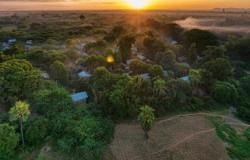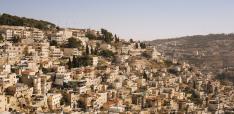REDD+ and the Peace Process: A Cornerstone for a Peaceful and Sustainable Future?

This year the Global Leadership Initiative at the University of Sheffield have taken a team of policy analysts to the Oslo REDD+ Exchange - a gathering of 500 policy makers, government officials, civil society actors and indigenous peoples’ representatives discussing the reduction of emissions from deforestation and degradation. This post is part of a series of blogs and opinion pieces from the summit.
This blog draws on discussions which took place at the Oslo REDD+ Exchange between 500 policy makers, government officials, civil society actors and indigenous peoples’ representatives. This blog examines the debates from one panel session entitled REDD+ and Peace Processes: How can they be mutually supportive?
What is REDD+ and what has it got to do with peace?
REDD+ (Reducing Emissions from Deforestation and Degradation) is a policy mechanism for sustainable forest management, achieved through financially incentivising the conservation, protection and preservation of our forest’s rich environmental and social diversity. As an international initiative, REDD+ can take many forms and has recently emerged as a tool for furthering peace in post-conflict countries.
Combining REDD+ with peace building processes is a win-win situation according to Pablo Viera Samper, the Vice Minister of Environment and Sustainable Development of Colombia. Considering that since 2007 (when REDD+ was first instituted), more than half of the participating countries have experienced violent and/or militarised conflict, REDD+ must consider its emergent role as a peace building initiative.
How does REDD+ support the peace process?
Colombia, as introduced by Samper, provides a touchstone by which to explore the possibilities of peace building and REDD+. According to Samper, REDD+ has enabled Colombia (a country with a vast history of conflict) to facilitate peace by “taking away conflict opportunities”, generating new livelihood prospects, and transforming natural resource activities. Indeed, forest resources have previously been “honeypots” used by violent partisan groups to finance conflict, however the implementation of REDD+ serves to remove access to this potential source of capital, and thus reduces the potential for conflict.
REDD+ is also acting as a positive vehicle for peace beyond Latin America. Sialas Siakor, recipient of the Goldman Award for the Environment, highlights how REDD+ has aided Liberia’s transition out of conflict by providing the chance to change and re-build relationships between stakeholders. Additionally, REDD+ gave the State the opportunity to embrace transparent processes following secrecy and division during conflict.
What challenges are faced by REDD+ in the peace process?
The legacy of conflict leaves scars: both on the people and the physical environment. These scars create obstacles for the successful implementation of REDD+ as conflict can leave communities, governments and stakeholders in a state of trauma and vulnerability; and therefore for these groups, trusting REDD+ and its associated baggage can prove difficult.
Myanmar is at the beginning of a REDD+ pilot and Mr. Abreu, a civil society member from the country, acknowledges the numerous obstacles Myanmar faces. Rival factions who control autonomous areas of forest (this in itself may be “tied directly to grievances” underlying the conflict) have differing approaches to deforestation, and these fragmented policies make it virtually impossible to implement a homogenous version of the REDD+ scheme, even on a local scale.
Furthermore, the capacity of Myanmar to (re)accommodate displaced populations and implement REDD+ practices was also raised. With a return of refugees, comes a subsequent demand for land; and this uncertain land tenure was cited by 50% of delegates at the Oslo REDD+ Exchange as the main challenge for Myanmar and the implementation of REDD+ practices moving forward.
Given the debates occurring at the conference, it became apparent that REDD+ as a policy actor in fragile states, could be viewed as a further catalyst for the exacerbation of conflict stresses. According to Blundell (Former Chair of the UN Security Council Panel of Experts on Liberia), advocates of REDD+ insist they are not a “trigger” for reoccurring conflict, but realistically, it is likely that attempts to introduce top-down policy mechanisms, will face difficulties in cohesively bringing together conflicting stakeholders.
Moving forward: can REDD+ and peace building be mutually supportive?
REDD+ and peace processes are not yet recognised as issues which go hand-in-hand; only 15% of peace agreements mention natural resources and there is insufficient research on the subject.
Blundell acknowledged that Colombia’s success in the pairing of REDD+ and peace building is an exception and not the rule, and that there is a long way to go before the affiliation is recognised in mainstream policy. It is evident, that shortcomings which are familiar to REDD+ on a wider scale are replicated in REDD+ and peace building discussions- such as concerns over the desire for a “quick win” (the logging industry provides immediate revenue, compared to the transparency and related bureaucracy involved in REDD+ funding).
All these debates beg the question, is REDD+ overreaching its remit by participating in post-conflict situations? For example, should REDD+ compete against the cocaine market in Colombia? Blundell noted that if REDD+ doesn’t play a part in these locations, it would ignore over 40% of the world's forest and these issues do seem intrinsically tied together. Discussion surrounding REDD+ and its relationship with the peace process has generated more questions than answers. Due to the murky role of business during conflict REDD+ must ensure transparency and sensitivity when affiliating with the private sector. However, with increased security costs in post-conflict countries, REDD+ needs access to funding and a helping hand from the “power of business.” The catch-22s that plague much of REDD+ debate are already entrenched in discussion regarding the programme’s peace building contributions. However, one can hope that the enthusiastic partnerships which appeared to be on the cards at the Oslo REDD+ Exchange can be put into practice, and the peace building process can help embed REDD+ as a vehicle for positive social, environmental and economic change.
The Oslo REDD+ Exchange team: Anna Laing, Eric Waweru, Thomas Bates
Photo credit: Christopher.Michel via Source / CC BY


